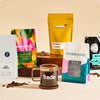If you’re shopping for specialty coffee and visit Trade to see all that we have to offer, you’ll notice that one of the many ways to sort all those coffees is by “type." That basically means whether you are looking for a coffee blend or a single origin, we have many different types of coffee. On the surface, hose two terms are super simple but by digging into them a little, we can learn so much about what we’re drinking and how it gets to us.
Single Origin Coffee
A fine blanket definition for single origin coffee is coffee that comes from one place, whereas a coffee blend is made up of coffees that are from different places. But while those definitions are helpful enough, they’re actually pretty inexact. The word “place,” specifically, is hard to define given the many varied ways the coffee supply chain can work. Coffee that comes from one coffee farmer is obviously a single origin. That being said, most farms in the coffee industry aren’t big enough to produce coffee to export on their own. So “single origin” can mean:
- Coffee from one specific plot of land on a farm
- Coffee from one specific farm
- Coffee from one co-operative representing several farms
- Coffee from one mill that buys coffees from many local farms and blends them together
- Coffee from one region, purchases by an exporter from several small wet mills
These are all slightly different levels of specificity, but they’re close enough to that definition of coffee that comes from one place that we can group them together. If you’ve ever wondered how single origin coffee beans get their names, a lot of the time it’s just one of these pieces of origin information. With very few exceptions, if a bag of coffee is exported and a roaster doesn’t combine it with any different bags of coffee, that’s a single origin coffee.
Blend Coffee
Coffee blends are two or more different single origin coffees sold as a combination. Some coffee roasters blend coffees before roasting, while others roast them separately and blend after, but either way, the result is a new coffee with the characteristics of all its components.
There are many reasons to blend. One is consistency; we’ve written before about coffee seasonality, and how coffees from different origins are harvested throughout the year. By blending, a roaster can combine different coffee beans throughout the year to achieve a similar result. For example, if you’re using a Guatemalan coffee in your blend in the late summer and early fall and that coffee has a medium body, medium acidity, and some red fruit flavors, you might be able to find a Papua New Guinea in late fall and a Peru in late winter that delivers similar flavors and tasting notes for a similar price. Say you’re blending all those coffees 50/50 with a Colombia (an origin that’s available more or less year-round) in a medium roast house blend; that blend won’t taste exactly the same throughout the year, but it’ll be close enough that customers who value consistency won’t be too upset.
Blending can also be a sort of alchemy. While many coffee roasters are working to dispel the stereotype of blends as a place to use low-quality coffees, two coffees together can be better—or more balanced—than either is alone. To use a fairly common pairing, Brazil produces a lot of coffees that have a lot of body but very low acidity. While it’s easy to find a Colombian coffee that has a good amount of acidity and not a ton of body (needless to say, both countries also produce a lot of very complex and balanced coffees, which tend to be more expensive). If you put those coffee blends together you can make a balanced medium-body, medium-acidity coffee that’s likely to appeal to more people.
Of course, many roasters are getting more creative than that. Blends of two coffees from Ethiopia, usually one washed and one natural process, are becoming more and more common and I suspect other surprising combinations are just around the corner as well.
So, while you’re still slightly more likely to find something really unique looking through single origin coffees rather than coffee blends, there’s nothing that definitively says that has to be the case. If you’re a coffee lover looking to really nerd out about coffee and explore the difference between coffee origins and coffee processing methods , buying single origin coffees is an easier way to do that. But don’t discount some of the totally delicious things being accomplished by roasters through blends. And remember: whether coffee is a blend or a single origin, they’re all just coffee in the end.





